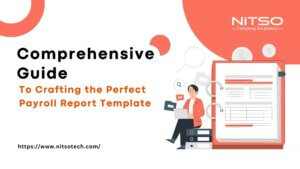Payroll reporting is a critical aspect of managing a business’s finances and ensuring compliance with relevant regulations. It involves the systematic documentation and analysis of employee compensation, taxes, deductions, and other related data. By accurately recording and reporting payroll information, organizations can maintain transparency, meet legal obligations, and make informed financial decisions.
Accurate payroll reporting plays a significant role in building trust among employees. It ensures that employees are compensated correctly, taxes are deducted accurately, and benefits are properly accounted for.
So, let’s dive into the world of payroll reporting and discover how it can benefit your organization and contribute to its overall success.
Table of Contents
What is Payroll Reporting?
Payroll reporting is the systematic process of documenting and analyzing employee compensation, deductions, taxes, and other related financial data within an organization. It involves the creation and maintenance of accurate records that track various aspects of employee payments, such as wages, salaries, bonuses, overtime, and benefits.
Definition of Payroll Reporting
Payroll reporting can be defined as the methodical collection, organization, and presentation of payroll information in a structured format. It provides a comprehensive overview of the financial transactions associated with employee compensation, ensuring transparency and accountability.
Purpose of Payroll Reporting
The primary purpose of payroll reporting is to enable businesses to effectively manage their payroll-related processes and comply with legal requirements. It serves several key purposes, including:
- Financial Management: Payroll reporting allows organizations to analyze labour costs, track budget allocations, and forecast future expenses. It provides insights into employee compensation trends, enabling better financial planning and decision-making.
- Regulatory Compliance: Accurate payroll reporting ensures compliance with various laws and regulations governing wages, taxes, and employment. By maintaining precise records, businesses can meet their legal obligations, such as withholding the correct amount of taxes and providing accurate wage statements.
- Employee Transparency: Payroll reports offer employees visibility into their earnings, taxes, deductions, and benefits. Transparent reporting builds trust, fosters employee satisfaction, and minimizes potential disputes or misunderstandings regarding compensation.
- Management Reporting: Payroll reports provide management with valuable data for analyzing employee costs, productivity, and performance. This information can be used to assess workforce efficiency, identify areas for improvement, and make strategic decisions related to compensation and benefits.
4 Types of Payroll Reporting
Payroll reporting can be executed through various methods, depending on the size of the organization, its complexity, and the available resources. Here are a few common types of payroll reporting:
1. Manual Payroll Reporting
Manual payroll reporting involves manually collecting, calculating, and documenting payroll data using spreadsheets, paper forms, or other manual methods. While this approach may work for small businesses with a limited number of employees, it becomes increasingly time-consuming and error-prone as the workforce expands. Manual reporting often lacks the efficiency, accuracy, and scalability required for larger organizations.
2. Payroll Reporting Software
Payroll reporting software is a digital solution that automates and streamlines the entire payroll reporting process. It eliminates the need for manual calculations and data entry, significantly reducing the chances of errors and improving efficiency. Payroll reporting software typically includes features such as employee record management, automated tax calculations, benefits tracking, and comprehensive reporting capabilities. It allows businesses to generate accurate payroll reports with ease and provides a centralized platform for managing payroll-related tasks.
3. Outsourced Payroll Reporting
Some organizations choose to outsource their payroll reporting functions to third-party service providers. These providers specialize in managing payroll processes, including reporting, tax filings, and compliance. Outsourcing payroll reporting can be beneficial for businesses that prefer to offload the administrative burden and ensure compliance with complex payroll regulations. It allows organizations to focus on their core operations while relying on experts to handle payroll-related tasks.
4. Cloud-based Payroll Reporting
Cloud-based payroll reporting is a modern approach that leverages online platforms and services to manage payroll data and reporting. With cloud-based solutions, businesses can securely store employee information, access payroll reports from anywhere with an internet connection, and benefit from regular updates and backups. Cloud-based payroll reporting offers convenience, scalability, and real-time access to data, making it an attractive option for businesses of all sizes.
5 Common Features of Payroll Reporting Software
Payroll reporting software offers a range of features designed to simplify and streamline payroll processes. These features not only enhance efficiency but also ensure accuracy and compliance. Let’s explore some of the common features found in payroll reporting software:
1. Employee Record Management
Payroll reporting software allows businesses to maintain comprehensive employee records, including personal information management (PIM), tax details, benefits enrollment, and employment history. It provides a centralized database for storing and updating employee data, eliminating the need for manual record-keeping and reducing the risk of data discrepancies.
2. Automated Calculations
One of the key advantages of payroll reporting software is its ability to automate complex calculations. It accurately calculates wages, taxes, deductions, and benefits based on predefined rules and regulations. Automated calculations not only save time but also minimize the likelihood of errors, ensuring employees are paid accurately and in compliance with legal requirements.
3. Tax Compliance
Payroll reporting software keeps track of tax-related information and assists businesses in meeting their tax obligations. It automatically calculates and withholds the correct amount of taxes from employee paychecks, generates tax forms such as W-2s, and facilitates the electronic filing of tax returns. By automating tax compliance, businesses can reduce the risk of errors, penalties, and late filings.
4. Reporting and Analytics
Comprehensive reporting capabilities are a fundamental aspect of payroll reporting software. It enables businesses to generate various reports, such as payroll summaries, tax reports, benefits statements, and labour cost analyses. These reports provide valuable insights into payroll trends, help monitor expenses, and support strategic decision-making.
5. Self-Service Portals
Many payroll reporting software solutions offer self-service portals for employees. These portals enable employees to access their payroll information, view pay stubs, update personal details, and manage benefits. Self-service functionality empowers employees by providing transparency and reducing administrative burdens on HR and payroll departments.
By leveraging these common features, payroll reporting software simplifies the payroll process, enhances accuracy, and improves overall efficiency. In the next section, we will discuss the importance of accurate payroll reporting and the potential risks associated with inaccuracies.

Importance of Payroll Reporting
Accurate and timely payroll reporting is crucial for businesses of all sizes. It not only ensures compliance with legal requirements but also provides valuable insights into financial management and employee compensation. Let’s explore the importance of payroll reporting in more detail:
1. Legal Compliance
Payroll reporting helps businesses comply with laws and regulations related to employee compensation, taxes, and benefits. By accurately reporting payroll information, businesses meet their legal obligations, such as providing accurate wage statements, withholding the correct amount of taxes, and adhering to labour laws. Non-compliance can result in penalties, fines, and legal disputes, highlighting the importance of accurate payroll reporting.
2. Financial Management
Payroll represents a significant portion of an organization’s expenses. Accurate payroll reporting provides businesses with a clear understanding of labour costs, allowing them to allocate budgets effectively, forecast future expenses, and make informed financial decisions. It enables businesses to assess the impact of compensation and benefits on their overall financial health and profitability.
3. Data-Driven Decision Making
Payroll reports offer valuable data for management to analyze workforce costs, productivity, and performance. By leveraging payroll reporting insights, businesses can identify trends, assess the impact of compensation structures, and make data-driven decisions. For example, analyzing overtime expenses may reveal opportunities to optimize staffing levels or streamline processes, resulting in cost savings and improved operational efficiency.
4. Audit and Record-Keeping
Accurate payroll reporting serves as a reliable audit trail and ensures proper record-keeping. Businesses may be required to provide payroll records during audits, tax filings, or legal disputes. By maintaining accurate payroll reports, businesses can easily retrieve and present the necessary documentation, reducing audit risks and ensuring compliance.
5. Planning and Forecasting
Payroll reports provide essential information for future planning and forecasting. Businesses can analyze historical payroll data to identify patterns, predict labour costs, and plan for future growth. Payroll reporting helps businesses align their compensation strategies with organizational goals and budgetary considerations, enabling effective workforce management.
Article you might be intrested in: Recognizing Employees: The Power of Appreciation
Risks of Inaccurate Payroll Reporting and How to Avoid Them
Inaccurate payroll reporting can pose several risks to businesses, including financial penalties, legal issues, and employee dissatisfaction. Here are some common risks associated with inaccurate payroll reporting and strategies to avoid them:
- Financial Penalties: Mistakes in payroll reporting can lead to penalties from tax authorities or regulatory bodies. Ensure accurate calculations, timely tax filings, and compliance with employment laws to mitigate this risk.
- Legal Compliance Issues: Inaccurate reporting may result in legal disputes related to wage discrepancies, benefits, or misclassification of employees. Stay updated on labour laws, maintain proper records, and seek legal guidance if needed.
- Employee Dissatisfaction: Errors in payroll reporting can cause employee dissatisfaction and harm employee morale. Double-check payroll calculations, promptly address errors, and provide transparent communication to build trust with employees.
- Reputational Damage: Inaccurate payroll reporting can damage a company’s reputation, leading to a loss of trust from employees, clients, and stakeholders. Prioritize accuracy, invest in reliable payroll systems, and maintain open lines of communication to protect your reputation.
- Audit Risks: Inaccurate reporting can increase the likelihood of audits and result in time-consuming investigations. Ensure accurate record-keeping, maintain payroll reports, and conduct regular internal audits to minimize audit risks.
To avoid these risks, businesses should prioritize accurate data entry, implement robust payroll software or outsource to trusted service providers, stay updated on legal requirements, and perform regular reconciliations and reviews of payroll reports.
Article you might be intrested in: Harness the Potential of Employee Management Software
How to Customize Your Payroll Reporting
Customizing your payroll reporting allows you to tailor the process to meet the unique needs of your business. By incorporating specific parameters and preferences, you can extract meaningful insights and streamline your reporting practices.
To create custom payroll reporting procedures, identify the specific data points and metrics that are most relevant to your organization. This may include aspects such as departmental cost allocations, project-based reporting, or customized earnings codes. By focusing on the data that matters most to your business, you can ensure that your payroll reports provide actionable information.
Many software solutions offer flexible reporting options and customization features. Explore the available settings and options within your chosen software to configure the reports according to your requirements. This may involve selecting the desired data fields, choosing specific filters or date ranges, and designing report templates that align with your business’s branding and formatting preferences.
Furthermore, engage with key stakeholders within your organization to gather feedback and understand their reporting needs. Consult with HR, finance, and management teams to ensure that the payroll reports deliver the insights they require for decision-making and analysis. By involving relevant parties, you can collaboratively design and customize reports that serve multiple business functions.
By customizing your payroll reporting, you can create tailored reports that provide valuable insights into your organization’s financials, workforce costs, and compliance. This customization empowers you to make data-driven decisions, streamline processes, and optimize your payroll management.
Article you might be intrested in: A Guide to Voluntary Retirement Schemes in HRM
Top 10 Tips and Tricks for Leveraging Payroll Reporting
Maximizing the benefits of payroll reporting requires not only accurate data but also strategic approaches. By implementing the following tips and tricks, you can enhance the effectiveness of your payroll reporting practices:
- Regularly Validate Data: Ensure the accuracy and integrity of your payroll data by conducting regular audits and reconciliations. Validate data inputs, verify calculations, and cross-reference with other relevant sources to identify and correct any discrepancies.
- Establish Clear Processes: Define and document standardized payroll reporting processes within your organization. This includes establishing timelines, assigning responsibilities, and implementing quality control measures to ensure consistent and timely reporting.
- Train Your Payroll Team: Invest in training for your payroll team to ensure they are well-versed in payroll reporting best practices, software utilization, and compliance requirements. Ongoing education and professional development will help them stay up-to-date with industry changes and optimize their reporting skills.
- Stay Compliant with Regulations: Stay informed about the latest labour laws, tax regulations, and reporting requirements relevant to your business. Compliance is crucial for avoiding penalties, legal issues, and reputational damage. Regularly review and update your processes to align with the evolving regulatory landscape.
- Utilize Data Analytics: Leverage the analytical capabilities of your payroll reporting software to extract valuable insights. Explore trends, identify patterns, and analyze cost drivers to make data-driven decisions regarding labour allocation, compensation adjustments, and benefits planning.
- Communicate Transparently: Maintain open and transparent communication with your employees regarding their payroll and benefits. Provide clear explanations of deductions, allowances, and other payroll components to ensure employee understanding and minimize queries or concerns.
- Automate Recurring Reports: Streamline your reporting processes by automating recurring reports. Set up scheduled report generation and distribution, reducing manual effort and ensuring consistent delivery of vital payroll information.
- Monitor Key Performance Indicators (KPIs): Identify and track key payroll-related KPIs that align with your business objectives. Examples include labour cost as a percentage of revenue, overtime utilization, or turnover rates. Regularly monitor these KPIs to assess performance, identify areas for improvement, and align payroll strategies with organizational goals.
- Regularly Evaluate Reporting Needs: Review your reporting requirements periodically to ensure they continue to meet the evolving needs of your organization. Consider feedback from stakeholders and assess the relevance and effectiveness of current reports. Adjust and customize your reporting processes accordingly.
- Engage with Payroll Service Providers: If you outsource your payroll reporting, maintain a strong partnership with your service provider. Communicate your reporting needs clearly, regularly review service level agreements, and ensure they align with your reporting requirements.
By implementing these tips and tricks, you can optimize your payroll reporting processes, enhance accuracy, and derive valuable insights from your payroll data.

10 Common Payroll Reporting Errors and How to Correct Them
Accurate payroll reportings is essential to ensure employees are paid correctly and in compliance with regulations. However, errors can occur, requiring prompt identification and correction. Here are some steps to help you identify and correct errors in your payroll reporting:
- Regularly Review Reports: Conduct regular reviews of your payroll reports to identify any inconsistencies or discrepancies. Compare the data against source documents, such as timesheets, tax forms, and benefit records, to ensure accuracy.
- Verify Calculation Accuracy: Double-check the calculations involved in your payroll reporting, including wages, taxes, deductions, and benefits. Utilize payroll software features that provide automated calculations, but always verify the outputs for accuracy.
- Conduct Reconciliations: Perform regular reconciliations between your payroll records and other financial data, such as bank statements or general ledger entries. This helps identify any discrepancies and ensures that all financial transactions align.
- Seek Employee Feedback: Encourage employees to review their pay stubs and report any discrepancies or concerns. Create a process for employees to easily communicate with the payroll department to address and rectify errors promptly.
- Stay Updated on Regulations: Stay informed about changes in payroll regulations and tax laws to ensure compliance. Regularly review and update your payroll processes accordingly to reflect any legal updates or requirements.
- Maintain Detailed Records: Keep thorough and organized records of all payroll-related documents, such as timesheets, tax forms, and payroll reports. Having comprehensive documentation readily available simplifies the process of identifying and resolving errors.
- Collaborate with HR and Finance Teams: Foster collaboration between your payroll, HR, and finance departments. Establish effective lines of communication to address any payroll-related issues and ensure alignment across departments.
- Implement Corrective Measures: Once an error is identified, take immediate action to rectify it. Determine the root cause of the error, implement necessary corrections, and communicate with affected employees to provide transparent explanations and resolve any concerns.
- Perform Test Runs: Before finalizing payroll reports, conduct test runs to verify the accuracy of the data and calculations. This enables you to identify and rectify errors before the reports are distributed to employees or submitted to relevant authorities.
- Seek Professional Assistance: In complex cases or when errors persist, consider consulting with payroll experts or hiring professional services to assist with error identification, correction, and process improvement.
Article you might be intrested in: The Significance of Continuous Learning and Development in Business Management
Payroll Reporting in India
Payroll reporting in India follows specific regulations and practices unique to the country. The Indian payroll landscape encompasses various legal requirements and statutory compliance obligations. Here are some key aspects to consider when it comes to payroll reporting in India:
- Statutory Compliance: Payroll reporting in India must adhere to statutory compliance obligations mandated by the government. This includes compliance with the Employees’ Provident Fund Organization (EPFO) for provident fund contributions, the Employees’ State Insurance Corporation (ESIC) for social security contributions, and the Income Tax Department for tax deductions and filings.
- Employee Provident Fund (EPF): The EPF is a compulsory retirement savings scheme applicable to organizations with 20 or more employees. Employers are required to deduct a specified percentage from employees’ salaries and contribute an equal amount to their EPF accounts. Accurate reporting of EPF contributions is essential for compliance and employee benefits.
- Professional Tax: Professional tax is a state-level tax levied on salaried individuals by some states in India. Employers are responsible for deducting professional tax from employees’ salaries and remitting it to the appropriate state authorities. Accurate reporting ensures compliance with the respective state laws.
- Tax Deduction at Source (TDS): Employers are required to deduct TDS from employees’ salaries as per the Income Tax Act. Accurate calculation and reporting of TDS amounts are critical to ensure compliance with tax regulations and to provide employees with the correct Form 16 for filing their income tax returns.
- Periodic Filings: In India, employers must file various periodic reports, such as monthly or quarterly returns, with government authorities. These reports include details of employee salaries, tax deductions, provident fund contributions, and other relevant information. Timely and accurate filing of these reports is essential for statutory compliance.
- Employee State Insurance (ESI): The ESI Act provides social security benefits to employees, including medical insurance and cash benefits. Employers must report accurate employee information and ensure timely remittance of ESI contributions to the ESI Corporation.
- Local Labour Laws: Each state in India may have additional labour laws that employers must comply with regarding working hours, leave entitlements, minimum wages, and more. Payroll reporting should incorporate these local labour law requirements to ensure compliance and avoid legal issues.
It’s crucial for businesses operating in India to stay updated on payroll regulations, consult with local experts, and leverage technology solutions that cater to the unique requirements of Indian payroll reporting.
Article you might be intrested in: Boost Employee Engagement: Mastering Work-Life Balance
Conclusion
Payroll reporting is a vital component of managing employee compensation, ensuring legal compliance, and making informed business decisions. Accurate and timely reporting helps businesses track labour costs, maintain transparency, and foster employee trust and satisfaction.
By leveraging payroll reporting software and customizing reporting processes, businesses can streamline operations, minimize errors, and derive meaningful insights from payroll data. Regularly reviewing and correcting payroll reporting errors is crucial to maintain accuracy and compliance.
Remember, payroll reporting is not just about numbers; it impacts employee satisfaction, regulatory compliance, and financial management. By prioritizing accurate payroll reporting, businesses can build trust, enhance operational efficiency, and contribute to their overall success.








0 Comments